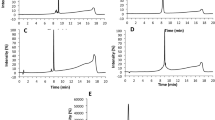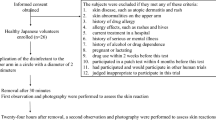Abstract
OBJECTIVE:
To assess the effect of bathing with water only or with mild pH neutral soap and water on skin flora of preterm newborns.
METHOD:
Randomized blinded clinical trial that enrolled 73 preterm newborns whose gestational age was between 28 and 35 weeks and birth weight between 800 and 1800 g. At the age of 3 days the infants were randomly assigned to a group that was given daily baths either with water only, or with soap and water for 7 or more days. Antibiotic treatment delayed onset of the trial in some preterm infants. On the final day of bathing axillary bacterial cultures were obtained before and 30 minutes after bathing.
RESULTS:
At the time of axillary culturing, the mean age of the newborns was 19 days. Coagulase-negative Staphylococcus was the most prevalent microorganism in both groups. No significant difference was found in the count of microorganism colonies between both groups. The comparison of the number of bacterial colonies between the time before and after bath, carried out by repeated-measures ANOVA showed a significant difference over time in the two groups, without a significant difference between the two groups.
CONCLUSIONS:
Bathing preterm newborns with water only or with soap and water produces similar effects on skin colonization of a preterm neonate. Both are effective to decrease the number of colonies of Gram-positive and Gram-negative bacteria.
This is a preview of subscription content, access via your institution
Access options
Subscribe to this journal
Receive 12 print issues and online access
$259.00 per year
only $21.58 per issue
Buy this article
- Purchase on Springer Link
- Instant access to full article PDF
Prices may be subject to local taxes which are calculated during checkout


Similar content being viewed by others
References
Lund C, Kuller J, Lane A, Lott JW, Raines DA . Neonatal skin care: the scientific basis for practice. J Obstet Gynecol Neonatal Nurs 1999;28:241–254.
Gfatter R, Hackl P, Braun F . Effects of soap and detergents on skin surface pH, stratum corneum hydration and fat content in infants. Dermatology 1997;195:258–262.
Baranda L, Gonzalo-Amaro R, Torres-Alvares B, Alvares C, Ramírez V . Correlation between pH and irritant effect of cleansers marked for dry skin. Int J Dermatol 2002;41:494–499.
Lodén M, Buraczewska I, Edlund F . The irritation potential and reservoir effect of mild soaps. Contact Dermatitis 2003;49:91–96.
Fox C, Nelson D, Warechsm J . The timing of skin acidification in very low birth weight infants. J Perinatol 1998;18:272–275.
Yosipovitch G, Maayan-Metzger A, Merlob P, Sirota L . Skin barrier properties in different body areas in neonates. Pediatrics 2000;106:105–108.
Hoeger PH, Enzmann CC . Skin physiology of the neonate and young infant: a prospective study of functional skin parameters during early infancy. Pediatr Dermatol 2002;19:256–262.
Nix DH . Factors to consider when selecting skin cleansing products. J Wound Ostomy Continence Nurs 2000;27:260–268.
Lund C . Prevention and management of infant skin breakdown. Nurs Clin North Am 1999;34:907–920.
Saiman L, Ludington E, Dawson JD, Patterson JE, Rangel-Frausto S, Wiblin T . Risk factors for Candida species colonization of neonatal intensive care unit patients. Pediatr Infect Dis J 2001;20:1119–1124.
Ballard JL, Wedig K, Wang L, Ellers-Walsman L, Lipp R . New Ballard Score, expanded to include extremely premature infants. J Pediatr 1991;119:417–423.
Abramson JH, Gahlinger P . Computer Programs for Epidemiologists: PEPI v. 3.0. Salt Lake City, UT: Sagebrush Press; 2000.
Franck LS, Quinn D, Zahr L . Effect of less frequent bathing of preterm infants on skin flora and pathogen colonization. J Obstet Gynecol Neonatal Nurs 2000;29:584–589.
Savey A, Fleurette J, Salle BL . An analysis of microbial flora of premature neonates. J Hosp Infect 1992;21:275–289.
Evans ME, Schaffner W, Federspiel CF, Cotton RB, McKee T, Stratton CW . Sensitivity, specificity, and predictive value of body surface cultures in a neonatal intensive care unit. JAMA 1988;259:248–252.
D'Angio CT, McGowan KL, Baumgart S, Geme JS, Harris MC . Surface colonization with coagulase-negative staphylococci in premature neonates. J Pediatr 1989;114:1029–1034.
Cowan ME, Frost MR . A comparison between a detergent baby bath additive and baby soap on the skin flora of neonate. J Hosp Infect 1986;7:91–95.
Chiller K, Selkin BA, Murakawa GJ . Skin microflora and bacterial infections of the skin. J Invest Dermatol Symp Proc 2001;6:170–174.
Medves JM, O'Brien B . Does bathing newborns remove potentially harmful pathogens from the skin? Birth 2001;28:161–165.
Rowen JL, Atkins JT, Levy ML, Baer SC, Baker CJ . Invasive fungal dermatitis in the ≤1000-gram neonate. Pediatrics 1995;95:682–687.
Acknowledgements
The authors thank Prof. Dr. Mario Wagner for his assistance with the statistical analysis, and Dr. Suzana Barcellos for her assistance at Microbiology Laboratory.
Author information
Authors and Affiliations
Additional information
Financial assistance: This project was partially funded by the Hospital de Clínicas de Porto Alegre Research Incentive Fund (FIPE-HCPA) Grant no 02318.
Rights and permissions
About this article
Cite this article
da Cunha, M., Procianoy, R. Effect of Bathing on Skin Flora of Preterm Newborns. J Perinatol 25, 375–379 (2005). https://doi.org/10.1038/sj.jp.7211332
Published:
Issue Date:
DOI: https://doi.org/10.1038/sj.jp.7211332
This article is cited by
-
Effectiveness of different bathing methods on physiological indexes and behavioral status of preterm infants: a systematic review and meta-analysis
BMC Pediatrics (2023)
-
Recommendation for hygiene and topical in neonatology from the French Neonatal Society
European Journal of Pediatrics (2019)
-
Does skin cleansing with chlorhexidine affect skin condition, temperature and colonization in hospitalized preterm low birth weight infants?: a randomized clinical trial
Journal of Perinatology (2009)



